The Hidden Dangers of Programmatic SEO
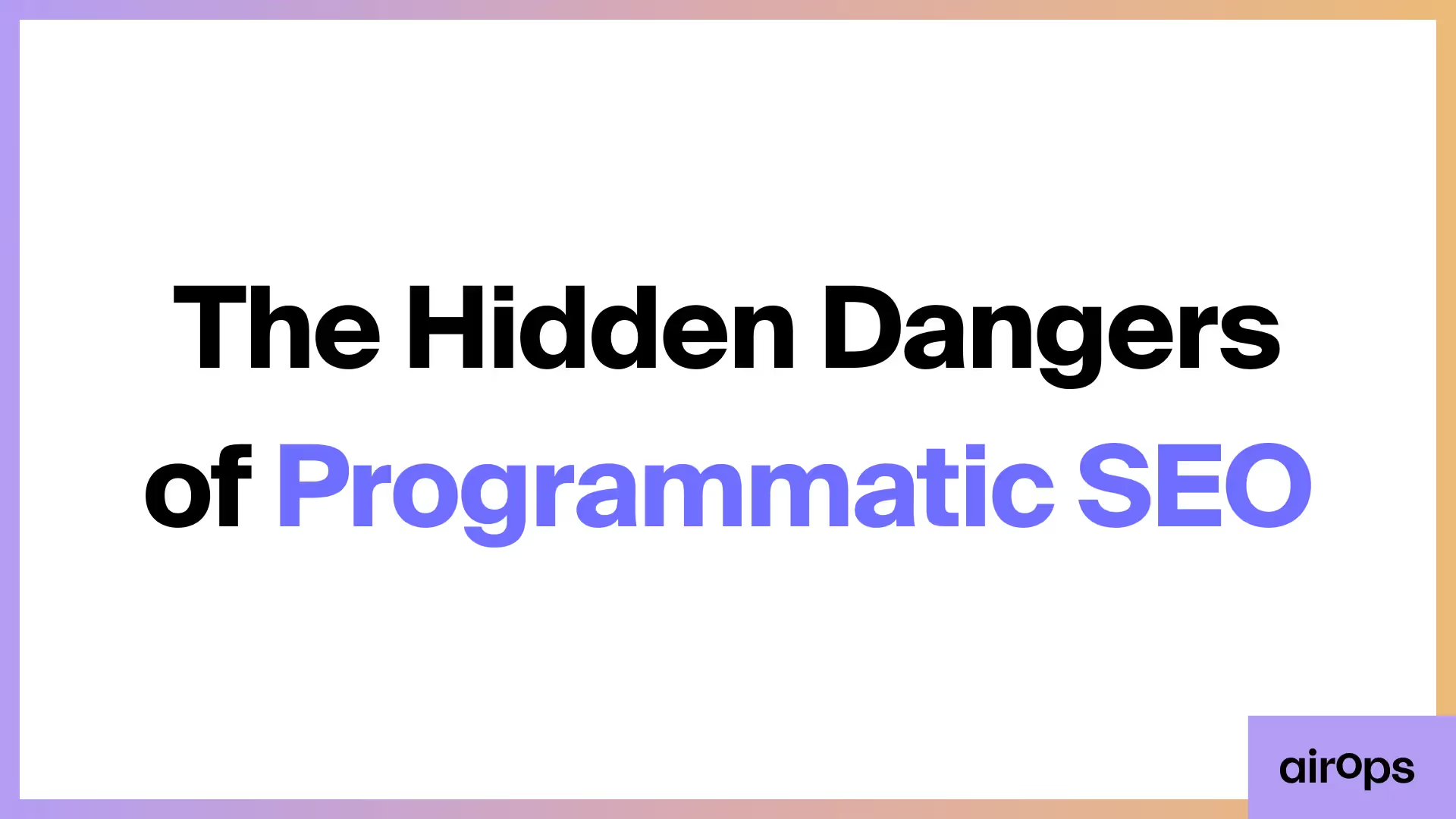
I’ve been bearish on programmatic SEO long before the proliferation of AI content scaling. Why? Because I’ve seen it fail more often than it succeeds.
In March of 2024, Google escalated its war on scaled content abuse along with many other types of spammy, low-quality content.
By April of 2024, the rollout completed. As a result, websites took a hit and the demand for experienced SEOs skyrocketed.
Diagnosing programmatic SEO issues
SEO consultants like myself are sought after to diagnose traffic losses and determine how to “clean up the mess” caused by a failed programmatic SEO strategy.
From my experience, two common symptoms are large ranking position drops and Google’s refusal to crawl and index thousands (or even millions) of programmatically generated pages.
Just head over to Google Search Console and navigate to the page indexing report to investigate why pages aren’t getting indexed.
The screenshot below represents a slide from an SEO audit I performed for a client where nearly 8 million pages were discovered, but just under 650K pages were crawled — this type of severe website bloating is the damage caused by a programmatic SEO wrecking ball.
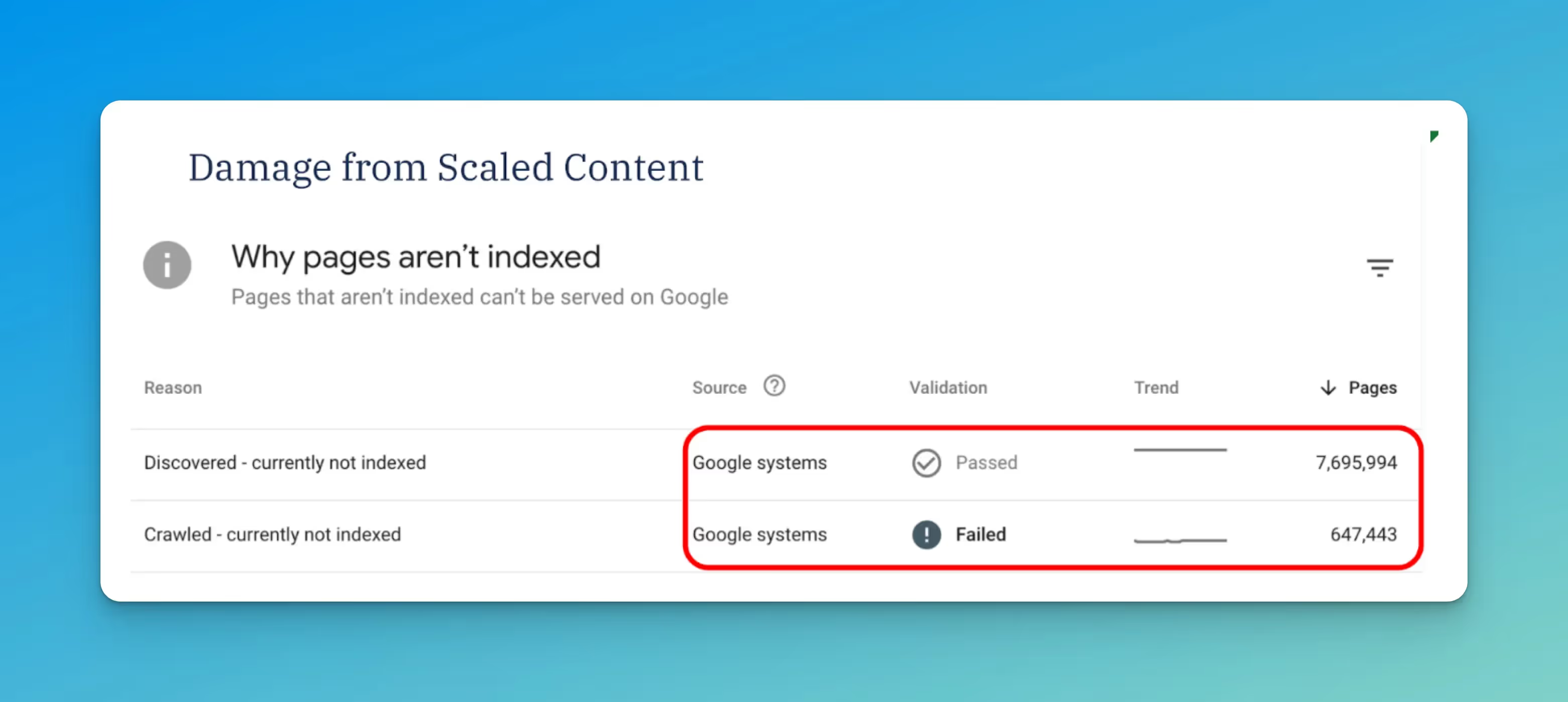
What exactly is programmatic SEO?
Programmatic SEO utilizes a database of information to auto-magically publish an enormous volume of content. This is typically done by feeding data inputs into a set of landing page templates which then auto generates hundreds of thousands (or even millions) of programmatic SEO pages.
Is programmatic SEO considered spam?
John Mueller from Google stated, “programmatic SEO is often a fancy banner for spam.”
And while I agree with John, I also believe that programmatic SEO isn't inherently bad — but it suffers from a lack of quality control.
Too many websites use programmatic SEO to churn out thin pages solely aimed at driving product signups, offering no value to users.
Google’s helpful content guidelines issued a warning on creating search engine-first content.
- Is the content primarily made to attract visits from search engines?
- Are you using extensive automation to produce content on many topics?
Therefore, programmatic SEO appears to be a direct conflict with “helpful, reliable, people-first content.”
What are the consequences of failed programmatic SEO?
- Index bloat.
- Content bloat.
- Traffic loss.
- Wasted crawl budget.
- Wasted resources.
- Wasted time.
But perhaps the biggest consequence of all is the long-lasting damage done to your domain. In other words, once your domain is “marked” it’s very difficult to reverse the curse.
Google says it may take several months before their systems are able to learn and confirm that your website is producing helpful, reliable, people-first content in the long term.
However, I’ve seen cases where even after de-indexation (410) of programmatic pages, it took Google one year to remove all pages from the index.
A recent study from Surfer SEO found that the helpful content update wasn’t really about content quality — but rather, overall site quality.
Therefore supporting the notion that a website plagued by low-quality content is likely to “drag down” the performance of high quality content along with it.
Is programmatic SEO worth it? These 3 Examples Say No.
Programmatic SEO promises large scale, speed, and efficiency. However, its fundamental flaw is the assumption that humans will engage and interact positively with the content.
Teams working on pSEO tend to focus on the technical aspects, such as sitemaps, internal linking structure, landing page templates, URL structure, metadata targeting specific search queries, etc.
However, they fail to consider whether or not a human will enjoy the content experience — or even worse — knowingly launch lackluster pages just so they can ramp up organic search traffic.
Example 1 — Algorithmic penalty
I recently worked with a client who fell into this exact trap. While they initially enjoyed a burst of organic traffic growth, it wasn't long before they experienced a sudden drop.
Google’s algorithms caught on, and they were hit with an algorithmic penalty. Following the penalty, Google refused to rank any of their new content — even in-depth “human produced” content struggled to rank.
This slide below is from an SEO Audit, which illustrates the consequences of their approach.
In this case, the October 2023 spam update marked the beginning of a sharp decline in their organic visibility. The damage inflicted was so severe that it's now undermining their current efforts and future SEO potential.
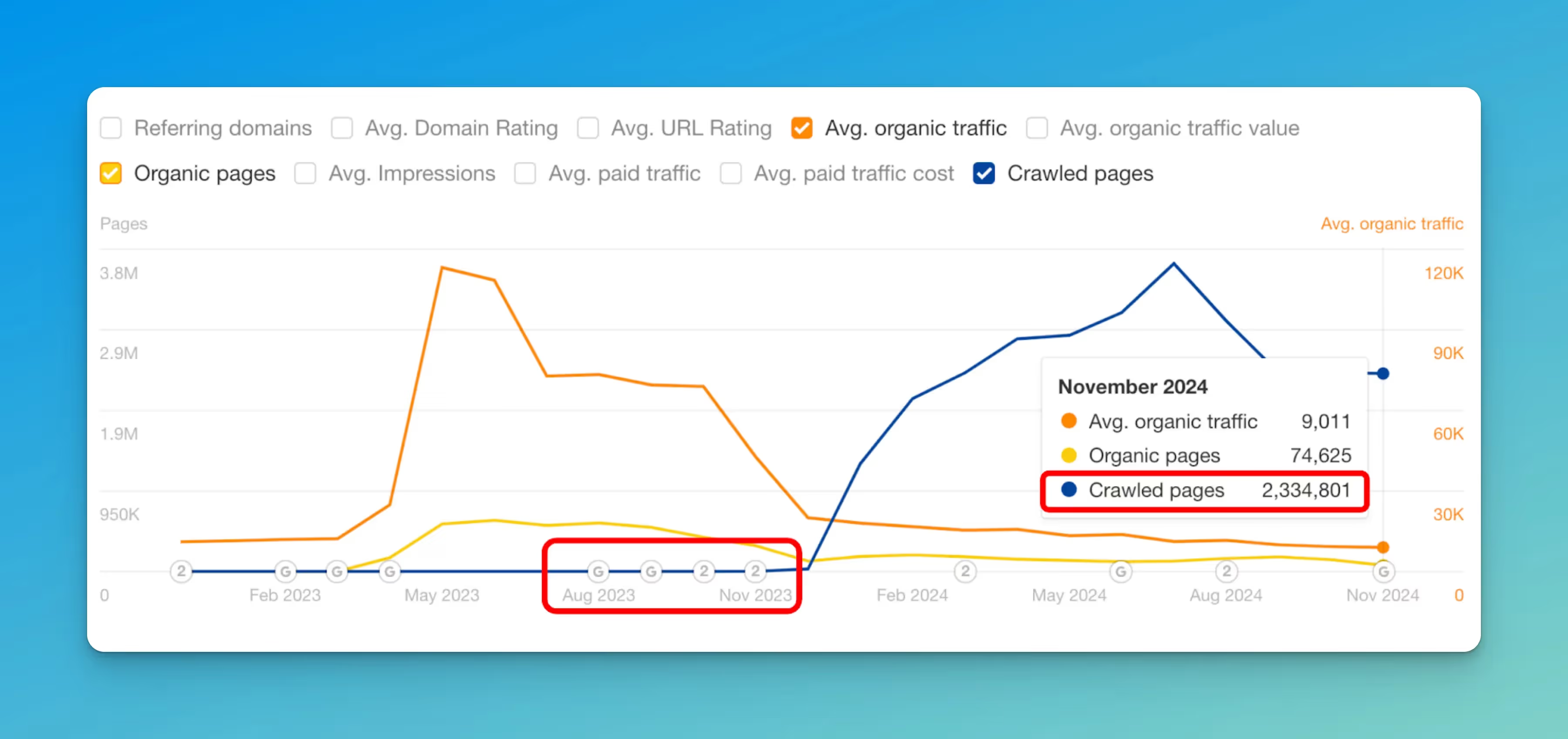
Example 2 — ZoomInfo
ZoomInfo is a classic example of the pSEO boom and bust cycle. They were the first in their category to take advantage of a prosperous “golden era” in SEO, and scaled their organic visibility on millions of programmatic SEO landing pages.
They leveraged database SEO to create company and people profile pages targeting specific keywords like "Wal-Mart employee contact info" and "Wal-Mart CEO email address."
Their goal was simple — to attract sales development reps searching for this information, leading them to ZoomInfo's paywall in order to drive product signups.
Being the first company to do this worked in their favor, as it gave them an advantage over all the competitors in their space (who would soon copy them). It worked exceptionally well for years, but you guessed it — they eventually tanked.
As competitors like Apollo, RocketReach and countless others copied their strategy, Google's algorithms evolved and ZoomInfo's organic visibility suffered a dramatic collapse.
Is there something ZoomInfo could have done differently? My hypothesis is that users were getting frustrated with the paywall found on pages like this — therefore, high bounce rates and low time on page were probably the cause of traffic loss.
Perhaps ZoomInfo could have sustained the traffic if they had done more landing page testing focused on improving the user experience.
Despite ZoomInfo’s SEO boom and bust, some marketers argue that the short-term gains from this strategy were ultimately worth it, since they grew their brand to massive levels and “milked the cow” for all it was worth.
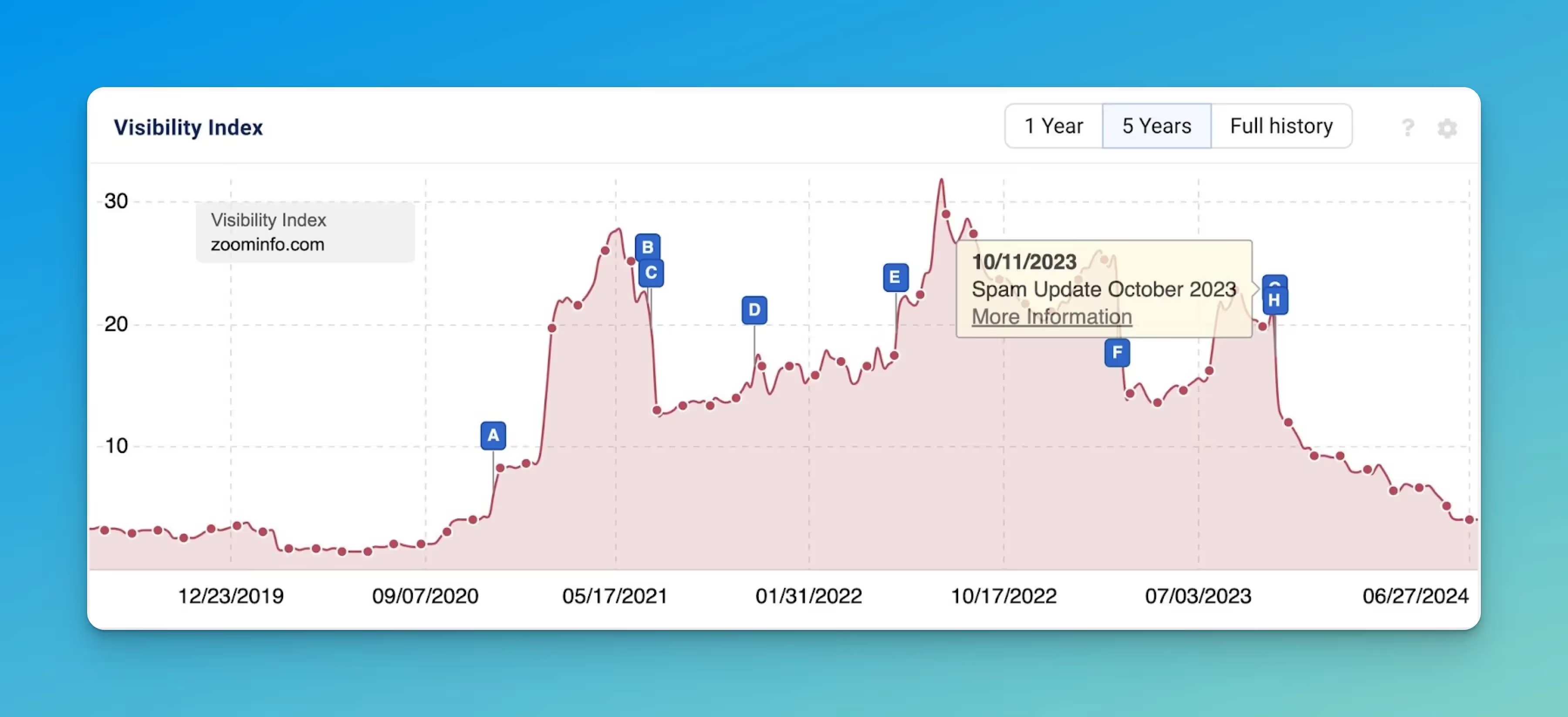
Example 3 — G2
G2 (and other software review sites who follow the same model) have long been over-reliant on programmatic SEO.
The bravery to live and die by the pSEO sword comes with a hefty price. G2 experienced a dramatic loss of organic traffic, estimated around 80% since 2023.
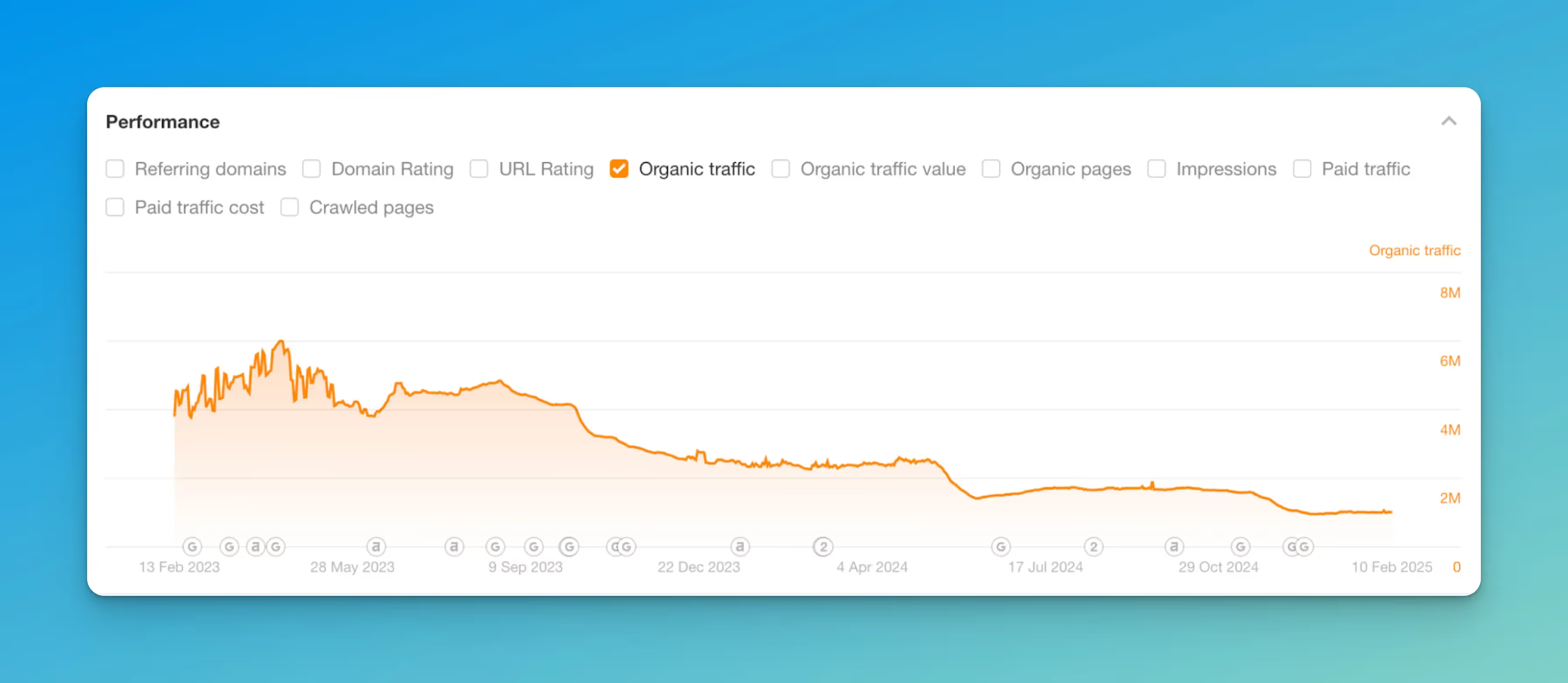
Take a look at “Best Endpoint Detection and Response Software”
Let's examine their performance for a keyword where they once ranked highly: best endpoint detection and response software.

Several factors most likely contributed to their drop in rankings for this term:
- User preference for editorial content: Users are actively seeking in-depth, insightful reviews written by experts. G2's reliance on programmatically generated database pages simply doesn't meet this demand, leading users to prefer content with more substance and analysis.
- Stronger, more authoritative competition: Top-ranking pages for competitive keywords like this are now dominated by high-quality articles from sources with demonstrable expertise in enterprise security. These articles are often written by recognized authorities, giving them a significant edge in terms of credibility and user trust.
- AI Overview limitations: AI algorithms need rich, meaningful text to extract information and create summaries, and G2's programmatically generated, thin content is a major disadvantage here.
- The rise of Reddit: Google has an undeniable love affair with Reddit. This cannot be ignored, irrespective of whether or not marketers believe Reddit offers more valuable, unique content to users. The sleazy world of Reddit marketing is worth a read.
- Increased competition and saturation: The software review market has become incredibly crowded. What was once a less competitive landscape is now filled with numerous affiliates and vendors aggressively fighting for top rankings. This makes it much harder for any single site, especially one relying on programmatic content creation, to maintain high visibility.
While G2 may have initially profited from a less competitive landscape and a novel approach to programmatic SEO, their over-reliance on this strategy has ultimately proven unsustainable.
Shifting user preferences, increased competition, the rise of alternative platforms, and the growing sophistication of search engine algorithms have all played a role in their substantial traffic decline.
Common pitfalls in programmatic SEO
Programmatic SEO is more complex than it appears. It's not just about generating large volumes of web pages to scale traffic — it's about creating page templates that don’t frustrate the end user.
With that in mind, here are some other key areas to watch out for.
SERP saturation
Don’t blindly copy your competitors!
If 10 other companies have already done the same idea before you, then it's probably too late. Going back to the ZoomInfo example, they were the first in their category to execute pSEO and then everyone copied their strategy.
All of these companies are using similar data sources targeting the same search terms, thereby causing SERP saturation and even worse — content sameness. There is not much that can be done to truly differentiate the content experience, and that’s why a challenger brand would be unlikely to outrank ZoomInfo.
Inability to index pages
Automation can introduce a host of technical problems — but the inability to get pages indexed is one of the biggest challenges with pSEO.
Kevin Indig said it best:
“Now, a domain and its content need to prove themselves… If the domain has too much low-quality content, Google might index only some pages or none at all in extreme cases.”
Another reason why it’s hard to get pages indexed is because you can’t really do link building for pSEO — that refers to both internal linking and backlinks.
You are largely relying on XML sitemaps, domain authority and site structure to get your content indexed.
Keyword cannibalization
Keyword cannibalization occurs when multiple pages on your website end up competing with each other for the same set of target keywords. This dilutes your ranking potential, as search engines struggle to determine which page is the most relevant.
In programmatic SEO, because you're generating numerous pages targeting long-tail variations of similar keywords, the risk of cannibalization is especially high. Careful keyword research, metadata copywriting and strategic grouping are essential to avoid this.
Lack of unique data
You need to consider the data sources available which can support a programmatic content strategy. A good example would be from Portable, an ex-client of mine that provides long-tail ETL solutions. We were able to programmatically rank for queries like “Datadog integration with Snowflake” because they are one of the few vendors offering such a bespoke ETL connector.
Unique datasets to work with are another smoking gun for pSEO. But above all, the main consideration for scaling programmatic SEO would be around page template optimization and surfacing the right data, UX, interactive content, driving user engagement signals, etc.
Thin content
Thin content refers to pages with little or no valuable information. These pages often lack depth, originality, and helpfulness for the user. Here’s an example. This is pretty common among SaaS and eCommerce.
Duplicative content
Duplicate content refers to content that appears on multiple pages of your website. This is common in pSEO because categories often have similar naming conventions, just worded slightly differently.
This is problematic for search engine optimization as it confuses crawlers and sometimes causes the wrong page to be prioritized in the SERPs.
Below is an example from TrustRadius.
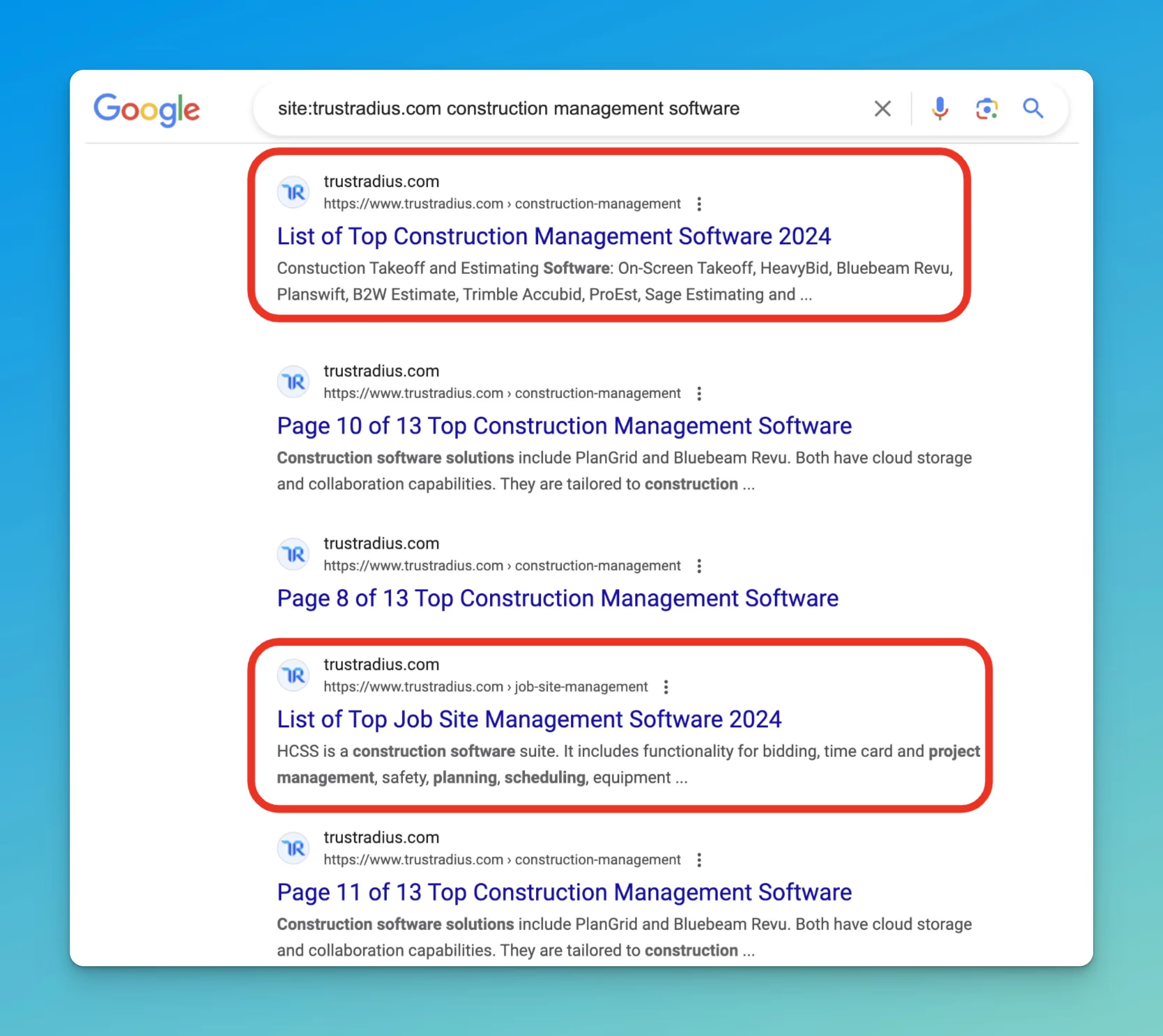
Balancing programmatic SEO with traditional content marketing
Programmatic SEO isn't about replacing all your content marketing efforts with automation. The golden rule is balance.
It's about blending programmatic SEO with a traditional content strategy to maximize overall SEO performance.
The ideal scenario is achieving both quality and scalability without sacrificing brand integrity.
This requires a nuanced approach. Programmatic SEO can help you efficiently target long-tail keywords, while classic content marketing can drive search rankings for head terms via pillar pages.
With that point of view, I suppose it would be possible to drive success with programmatic SEO, but the pages would have to be genuinely helpful and not just developed for search traffic and driving user signups.
Programmatic SEO should complement, not replace, your traditional content marketing efforts. Here's how to effectively integrate the two:
Don’t sleep on classic landing page SEO
With Google’s harsh clap back against thin affiliation spam, I’ve noticed “X Best List” roundup pages have taken a hit, especially from affiliate publishers.
On the contrary, landing page SEO has made a comeback in 2025. This could be Google’s way of fighting back against spam — by rewarding well-optimized product pages that are aligned to a brand’s topical authority.
Two examples of great landing page SEO are Teramind’s insider threat detection page and Aura’s identity theft protection page.
Both pages rank for extremely competitive keywords — but there’s no templatizing or SEO automation involved.
Instead, these are “hand-crafted” pages built with a high degree of precision.
I have not seen any examples of programmatic content ranking for high difficulty keywords by exclusively using ChatGPT or database SEO.
Of course, the tradeoff is that you need backlinks to rank “customized” landing pages for commercial intent keywords.
Whereas with programmatic SEO, it’s not going to be a rat race for backlinks, but rather more emphasis on technical SEO, sitemaps, etc.
Tie keyword research to customer use cases (JTBD)
Don't aimlessly chase search traffic based on the perceived ease of ranking. The most valuable traffic often comes from transactional keywords that align with the actual problems of your target audience.
Focus on finding scalable keyword patterns that are relevant to your business and demonstrate a clear connection to solving user pain points.
These are the keywords that will not only drive traffic but also attract qualified leads who are more likely to convert.
Prioritize understanding the user's intent behind their searches and create content that directly addresses their specific challenges.
Optimize content for information gain
Content should offer substantial information gain to the user. This means providing genuinely new insights, perspectives, or practical advice. The days of content rehashing are dead.
You can’t really achieve information gain by the old-world method of SEO e.g. keyword research, content briefs and outsourcing assignments to freelancers.
Instead, you must do things like:
- Extract customer insights (by talking to them) or at least by listening to customer calls.
- Hire researchers to source unique data which can then be applied to search-optimized content.
- Work with subject matter experts to get unique perspectives that are not available elsewhere.
Who's doing it well?
While many companies are experimenting with programmatic SEO, there’s a few hitting it out of the park!
Zapier
Zapier, a workflow automation tool, cleverly uses programmatic SEO to connect its vast network of integrated applications. With an estimated 800,000+ pages, their app directory isn't just a list; it's a powerful search engine for automation possibilities.
Each page focuses on a specific app integration, showcasing the workflows (Zaps) that can be triggered. This strategy not only drives significant organic traffic (estimated at 300,000+ monthly visits) but also serves as a valuable resource for users seeking to automate their work.
By targeting long-tail keywords related to specific app combinations (e.g., "connect Mailchimp to Google Sheets"), Zapier effectively captures users actively looking for solutions.
This is a genius ecosystem SEO play, and they absolutely pulled it off to perfection.
Webflow
Webflow, a no-code website builder, demonstrates how programmatic SEO can showcase user-generated content and drive business growth. With an estimated 30,000+ pages, their template directory offers a diverse range of designs created by the Webflow community. Each template has its own dedicated landing page, optimized for relevant keywords.
This strategy not only generates organic traffic (estimated at 27,000+ monthly visits) but also cleverly promotes the platform itself. By allowing users to easily clone templates, Webflow lowers the barrier to entry and encourages new users to join their platform. Miro is another example of a company that delightfully pulled off this strategy by leveraging UGC to launch a scalable template library.
Wise
Wise (formerly TransferWise), an international banking service, leverages programmatic SEO to meet a very specific user need: currency conversion. With an estimated 14,000+ pages, they've created individual pages for virtually every currency pair imaginable (USD to INR, INR to MXN, etc.).
This granular approach targets users searching for specific currency conversions, resulting in an impressive estimated 4.6 million+ monthly organic visits. By providing a simple, direct solution to a common problem, Wise captures a massive audience and positions itself as a go-to resource for international financial services.
Zillow
Eli Schwartz talks about the genius of companies like Zillow that have mastered the art of product-led SEO and integrated their approach with pSEO to build scalable content operations. Zillow was able to estimate the commercial real estate value of every property in their database and build ultra long-tail landing pages based on queries associated with specific addresses.
Canva vs. Adobe
Kevin Indig wrote an excellent SEO case study explaining how Adobe and Canva are duking it out.
Canva’s template library is a monster pSEO play, driving an estimated 1.3M visitors per month.
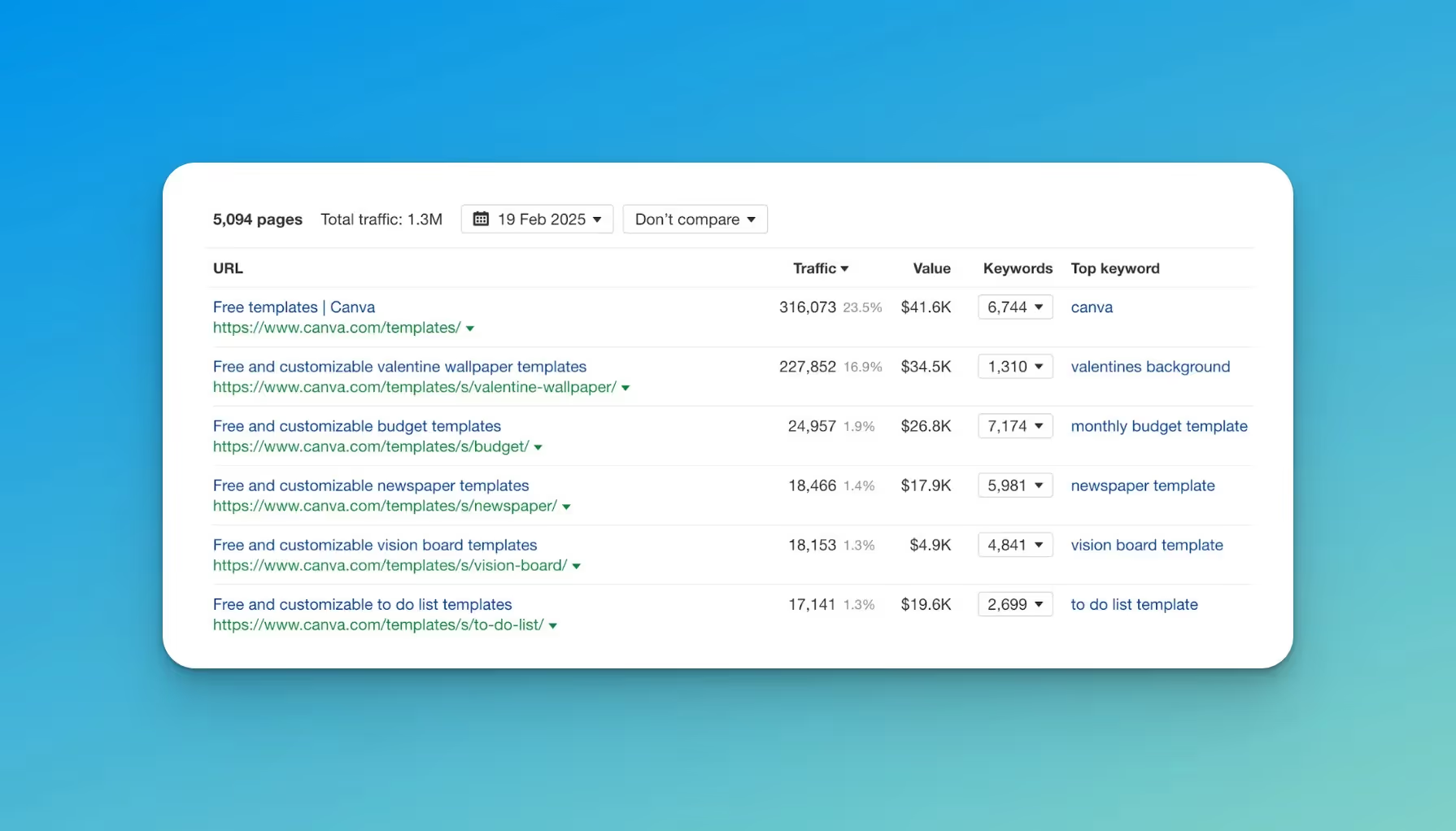
Adobe launched JTBD focused use case pages within their Acrobat folder, driving an astonishing 3.5M estimated monthly traffic!
While Canva’s template library is impressive, my instinct says Adobe’s /acrobat/ pages are more valuable because they are solution oriented, and therefore likely to have better conversion rates.
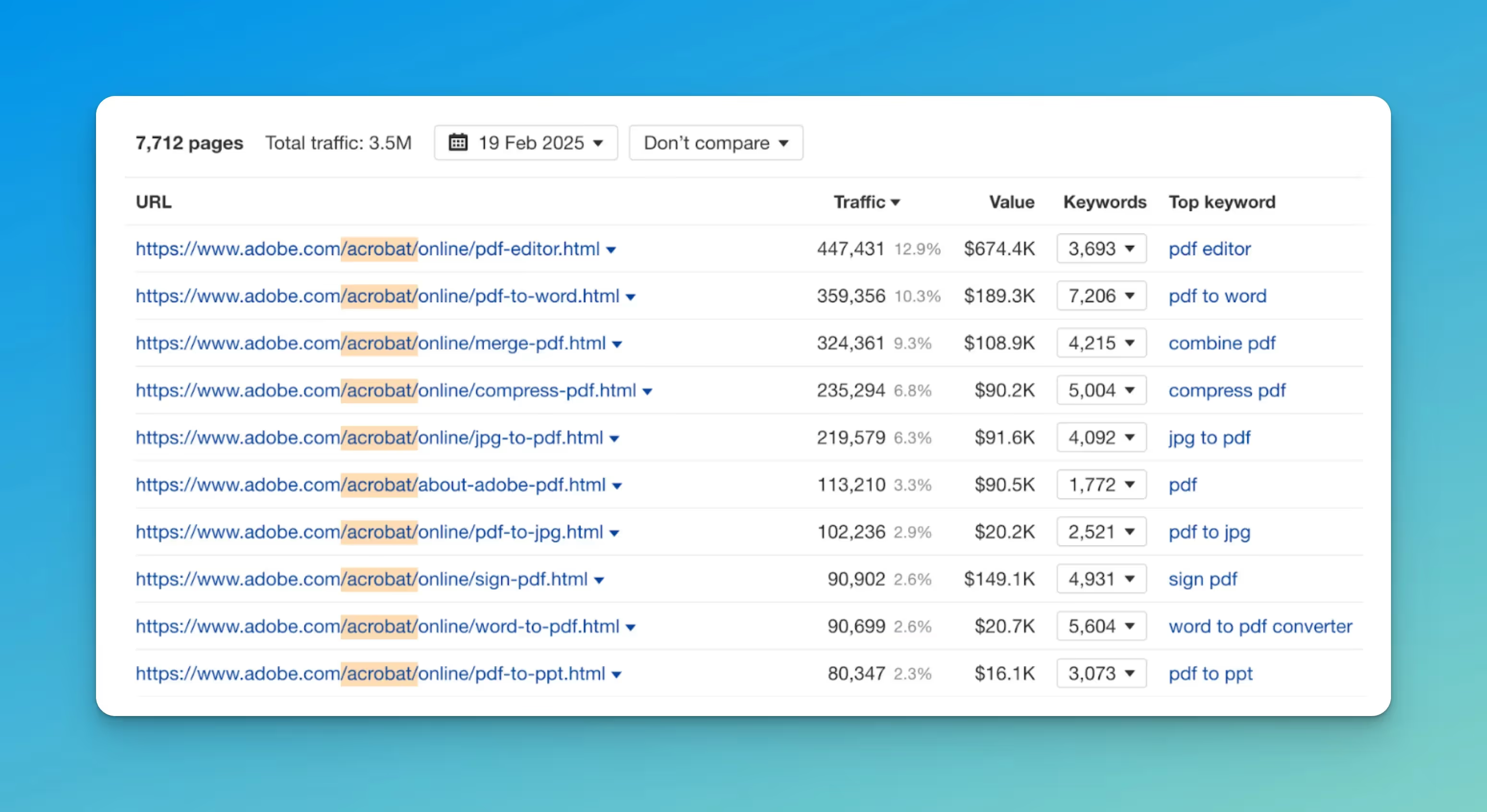
Creating valuable content with AirOps
As we've seen, programmatic SEO can be a double-edged sword. While it offers incredible potential for scale and efficiency, it also presents significant risks. That's why it's crucial to choose a platform that addresses these challenges head-on.
AirOps is a content orchestration platform built to do just that. It empowers marketers to execute programmatic SEO effectively by combining the efficiency of automation with the intelligence of human expertise.
But what truly sets AirOps apart is its distinct approach, one that resonates deeply with my own philosophy about content and SEO.
Here's why their approach stands out:
Empowering human expertise
AirOps recognizes that machines can't do it all. Their platform is designed to augment human capabilities, not replace them. It streamlines workflows, making it easier for writers, editors, and SEOs to collaborate and ensure every piece of content, whether generated automatically or manually, meets brand standards and SEO goals. This focus on human oversight aligns perfectly with my belief that thoughtful, high-quality content requires a human touch.
Flexibility for diverse needs
One size doesn't fit all in content marketing, and AirOps understands this. AirOps offers customizable AI workflows that adapt to a wide range of content strategies.
- Human-in-the-loop automation: AirOps recognizes the limitations of pure AI-driven content generation. Incorporates human oversight and review at every stage, ensuring quality, brand alignment, and thoughtful content that resonates with your audience.
- Customization and flexibility: AirOps offers customizable workflows and templates, allowing you to tailor the platform to your specific needs and content strategy. Whether you need detailed briefs, keyword optimization tools, or multi-format content generation, AirOps provides flexibility in each workflow step.
- Focus on quality and originality: AirOps prioritizes the creation of unique, high-quality content that stands out from the crowd. Their platform helps you avoid the pitfalls of generic, thin content, ensuring your brand maintains its voice and authority, with brand kits and knowledge base.
- Proven Results: AirOps has a track record of success in various industries, helping businesses achieve significant results with SEO, like increasing organic traffic by 50% for Anne Klein and increasing the number of customers from organic search like at Wyndly.
Is programmatic SEO worth the risk?
I think pSEO is a bad move for startups who have not yet established a “brand base.” I wrote a guide on SEO for startups which covers how to get things going if you’re an earlier stage challenger brand.
Programmatic SEO is inherently risky, but I believe there are certain scenarios where it makes sense:
- If your company has access to unique data sets or UGC that can provide information gain.
- If there are thousands of low search volume, long-tail keywords which cannot be targeted by producing editorial content.
- If you have the internal resources to automate and maintain high-quality pages.
When done right, pSEO can be a powerful tool for achieving organic growth. The key lies in creating a great page experience with genuinely valuable content that serves a real purpose for the user.
This requires a more strategic and nuanced approach, one that prioritizes:
- User experience: Design pages that are informative, engaging, and easy to navigate.
- Unique data and insights: Offer something users can't easily find elsewhere.
- Optimized templates: Craft templates that address specific search intents and guide users towards conversion.
- Engagement and interaction: Encourage user participation through interactive content, social sharing, and community building.
Successful programmatic SEO requires us to rethink our approach to scaled content.
It's about finding the right balance between automation and human oversight, ensuring that quality and user experience never take a backseat to scale.
AirOps is a content orchestration platform built on these principles. They empower marketers to generate high-quality content at scale, without sacrificing brand integrity or user experience.
If you're looking to leverage the power of programmatic SEO while avoiding its pitfalls, talk to an AirOps expert to see if they are the right partner for your marketing team.
Gaetano Nino DiNardi is a growth advisor to software companies like Demandbase, Gong, Kustomer, Cognism, Workvivo, HockeyStack, Teramind and many others. Gaetano previously led in-house marketing teams at Pipedrive, Nextiva and Aura. He has 10+ years of experience in marketing with a proven track record of capturing demand via inbound channels. Gaetano is an SEO course instructor at CXL and is widely recognized as one of the top SEO experts in the B2B SaaS industry. Gaetano is also a musician and published writer on HBR, Fast Company, NASDAQ, and HubSpot. Find him on LinkedIn and Twitter and learn more about his SEO services.
Win AI Search.
Increase brand visibility across AI search and Google with the only platform taking you from insights to action.
Get the latest on AI content & marketing
Get the latest in growth and AI workflows delivered to your inbox each week



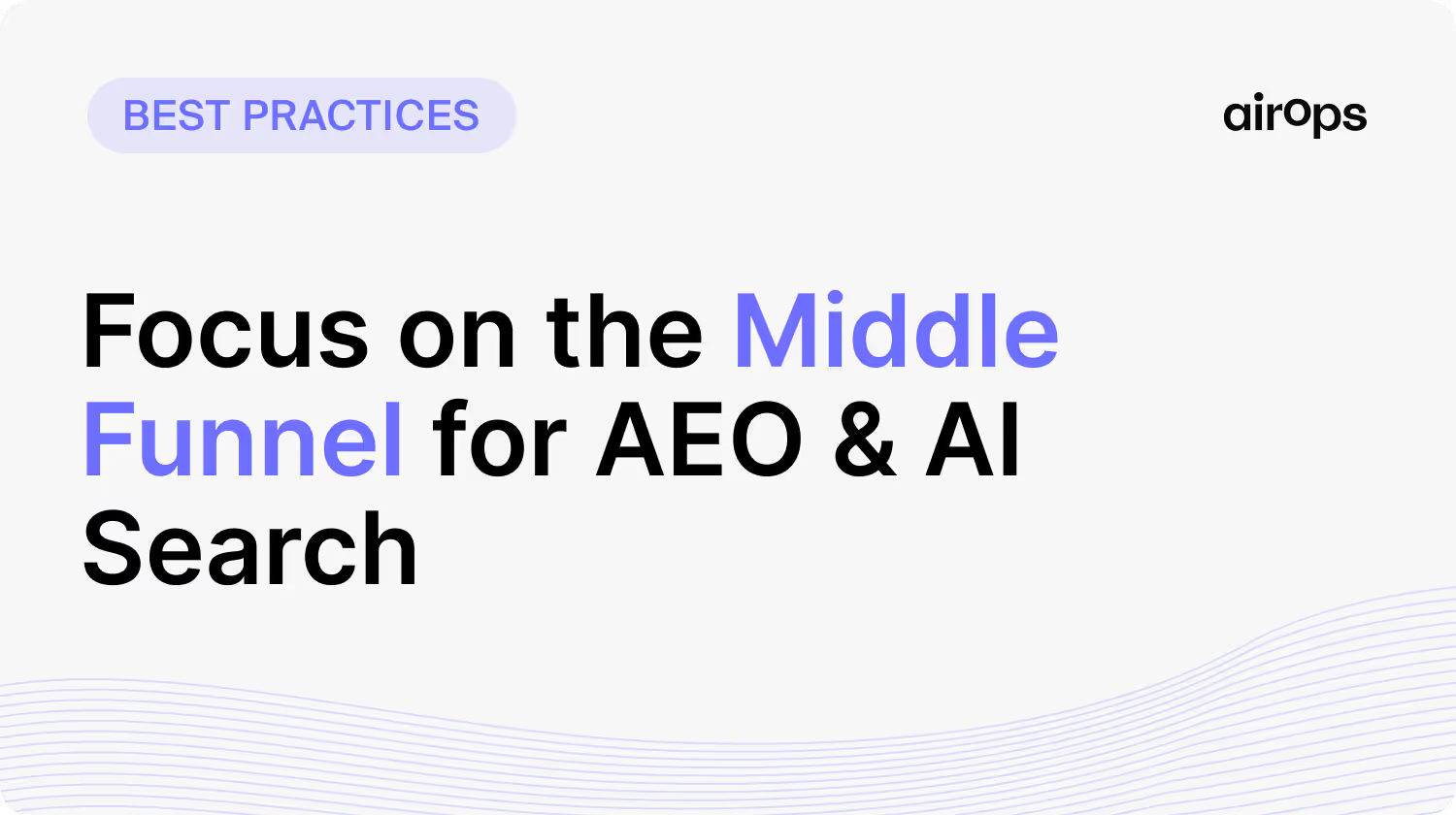

.avif)
.avif)
